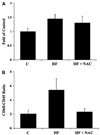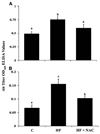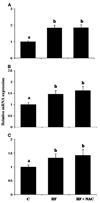N-acetylcysteine attenuates progression of liver pathology in a rat model of nonalcoholic steatohepatitis
- PMID: 18806095
- PMCID: PMC2935161
- DOI: 10.1093/jn/138.10.1872
N-acetylcysteine attenuates progression of liver pathology in a rat model of nonalcoholic steatohepatitis
Abstract
A "2-hit" model for nonalcoholic steatohepatitis (NASH) has been proposed in which steatosis constitutes the "first hit" and sensitizes the liver to potential "second hits" resulting in NASH. Oxidative stress is considered a candidate for the second hit. N-acetylcysteine (NAC), an antioxidant, has been suggested as a dietary therapy for NASH. We examined the effects of NAC in a rat total enteral nutrition (TEN) model where NASH develops as the result of overfeeding dietary polyunsaturated fat. Male Sprague-Dawley rats consumed pelleted AIN-93G diets ad libitum or were overfed a 9200 kJ.kg(-0.75).d(-1) liquid diet containing 70% corn oil with or without 2 g.kg(-1).d(-1) NAC i.g. for 65 d. Hepatic steatosis was not influenced by dietary supplementation with NAC; however, the liver pathology score was lower (P </= 0.05) and NAC provided partial protection against alanine aminotransferase release (P </= 0.05). NAC attenuated increased hepatic oxidative stress (TBARS; P </= 0.05) and prevented increases in cytochrome P450 2E1 apoprotein and mRNA and in tumor necrosis factor-alpha (TNFalpha) mRNA. Titers of auto-antibodies against proteins adducted to lipid peroxidation products were lower in serum of the NAC group than in the 70% corn oil group (P </= 0.05). NAC also decreased Picosirius red staining of collagen, a marker of fibrosis. However, markers of hepatic stellate cell activation were unaffected. Using NAC in a TEN model of NASH, we have demonstrated that NAC prevents many aspects of NASH progression by decreasing development of oxidative stress and subsequent increases in TNFalpha but does not block development of steatosis.
Conflict of interest statement
Author disclosures: January N. Baumgardner, Kartik Shankar, Leah Hennings, Emanuele Albano, Thomas M. Badger, and Martin J. J. Ronis have no conflicts of interest.
Figures






References
-
- Day CP, James OF. Hepatic steatosis: innocent bystander or guilty party? Hepatology. 1998;27:1463–1466. - PubMed
-
- Albano E. Free radical mechanisms in immune reactions associated with alcoholic liver disease. Free Radic. Biol. Med. 2002;32:110–114. - PubMed
-
- Chawla RK, Watson WH, Eastin CE, Lee EY, Schmidt J, McClain CJ. S-adenosylmethionine deficiency and TNF-alpha in lipopolysaccharide-induced hepatic injury. Am. J. Physiol. 1998;275:G125–G129. - PubMed
-
- Osmundsen H, Bremer J, Pedersen JI. Metabolic aspects of peroxisomal beta-oxidation. Biochim. Biophys. Acta. 1991;1085:141–158. - PubMed
-
- Mehta K, Van Thiel DH, Shah N, Mobarhan S. Nonalcoholic fatty liver disease: pathogenesis and the role of antioxidants. Nutr. Rev. 2002;60:289–293. - PubMed
Publication types
MeSH terms
Substances
Grants and funding
LinkOut - more resources
Full Text Sources
Other Literature Sources

